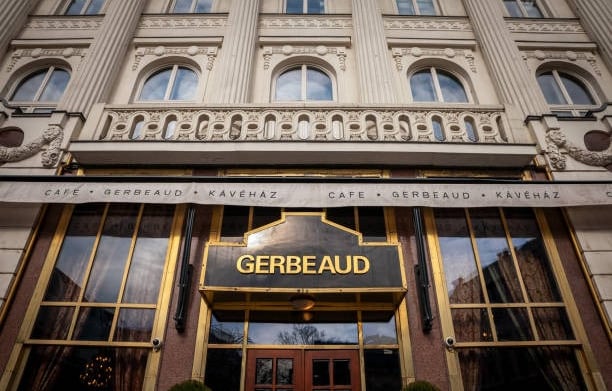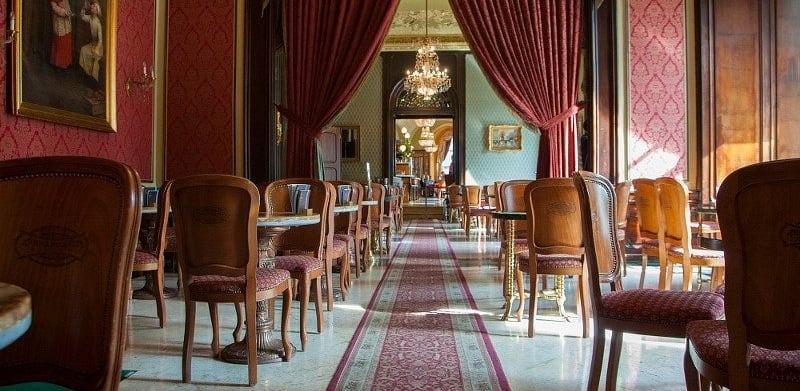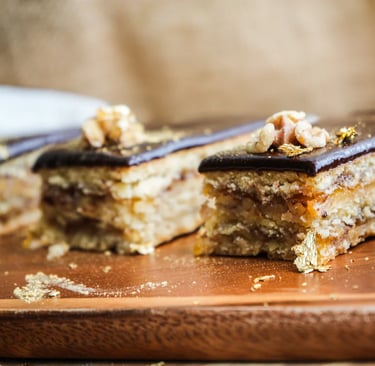Café Gerbeaud: Budapest's Sweetheart Since 1858
Where history, elegance, and confectionery artistry blend into a timeless experience.


A Place Where Time Bakes Slowly
In a world overrun by fast coffee, faster service, and cafes that look like they were designed in factory, Café Gerbeaud stands as an unapologetic monument to style and sugarcraft. Located in the heart of Budapest's elegant Vörösmarty Square, Gerbeaud is less a café and more a living monument, a portal to 19th-century grandeur served on a gilded plate with a side of apricot jam.
Step inside and you’re transported—not metaphorically, but architecturally. Velvet upholstery, crystal chandeliers, rococo ceiling frescoes, and marble-topped tables abound. The staff glide with grace. The menu is dense with layered tortes, sticky strudels, and creamy kuglófs that would make even Marie Antoinette put down her brioches and take note.
But this isn’t just about ornate interiors and impressive pastries. Gerbeaud is Hungary’s sweetest institution—and it has been shaping (and sugaring) Hungarian café culture since the 1800s.
The Origin Story: Of Cream, Craft and a Swiss Visionary
The story begins in 1858, with the arrival of a talented Swiss confectioner named Henrik Kugler. Kugler had studied in eleven of Europe’s finest pastry shops before settling in Pest, Hungary’s fast-growing capital, to open his own café. His little establishment on József Nádor Square quickly became the place to be. He introduced novelties like Chinese teas, Parisian bonbons and ice creams served in dainty porcelain cups. In a world still waking up to the idea of urban leisure, this was revolutionary.
Kugler later moved his café to Vörösmarty Square in 1870 and passed the business on to another Swiss genius, Emil Gerbeaud in 1884. A confectioner of even greater ambition, Gerbeaud turned the café into a palatial pleasure factory. He introduced mechanical production methods, set up an international delivery system and expanded the menu to include cakes, biscuits, liqueurs and chocolates that would quickly become household names across Europe.
He was also a marketing pioneer, branding pastries with the café’s name and designing intricate packaging that customers were eager to show off. His sense of design extended to the café’s ambiance: gilded stucco, brocade wallpaper, wood paneling from exotic trees, and enough marble to rival an imperial Roman villa.
The café thrived—and the name “Gerbeaud” became synonymous with luxury, indulgence and style.


Surviving the Storms of History
Gerbeaud has survived Austro-Hungarian grandeur, world wars, communist nationalization, and capitalist revival—emerging each time with its frosting intact.
During the communist era, the café was renamed “Vörösmarty Cukrászda” (as Gerbeaud was too bourgeois), and its lavishness was toned down—but never quite extinguished. After the fall of the regime, the café underwent careful restoration, and by the late 1990s, it was fully Gerbeaud again: name, style, and pastry pedigree.
A Cake List Worth a Coronation
You don’t go to Gerbeaud to eat a croissant and stare at your phone. You go to worship the torte.
Here are some of the edible icons you’ll encounter:
Gerbeaud Slice (Zserbó Szelet)
The house signature. A divine stack of yeast dough, ground walnuts, and apricot jam, topped with a chocolate glaze. It's Hungary on a plate—bold, nutty, a little tangy and unapologetically rich.
Dobos Torte
Named after pastry chef József Dobos, this is a Hungarian classic: six thin layers of sponge cake filled with chocolate buttercream and topped with a hard caramel glaze. It’s sharp, sophisticated, and a little crunchy on top—like Budapest herself.
Black Forest Cake (Fekete-erdő torta)
This Central European beauty comes with layers of chocolate sponge, whipped cream, and sour cherries soaked in cherry schnapps. Best consumed slowly, ideally with orchestral music playing in your head.
Creamy Gerbeaud Kuglóf
This traditional Hungarian bundt cake is fluffy, buttery, and laced with raisins and citrus zest. Often served warm, like a hug from your grandmother if she had a Michelin star.
And let’s not forget the strudels—apple, cherry, poppy seed—so thin and crisp you half expect them to shatter like glass when you touch them. They don't. They simply melt.
Not Just Cake: The Complete Gerbeaud Experience
While pastries are the headliners, the café also offers:
Coffee: Expect nothing short of Viennese-style excellence. Try the melange, or better yet, a Gerbeaud kávé, an espresso with whipped cream and hazelnut liqueur.
Hot Chocolate: Dark, dense, almost spoonable. Comes with whipped cream and a long pause to contemplate its richness.
Champagne and Cognac: Because sometimes dessert needs a partner in crime.
Savory Dishes: From Hungarian goulash soup to salmon tartare and duck liver paté. Ideal if you need something salty before surrendering to cake.
They also serve a delightful afternoon tea, complete with finger sandwiches and mini pastries—because if you’re going to pretend you're an aristocrat, you might as well go all the way.
Come for the Cake, Stay for the Architecture
The main salon is an architectural experience:
Stuccoed ceilings with floral motifs
Murano crystal chandeliers that sparkle even on cloudy days
Rosewood and mahogany paneling with gold accents
Marble floors polished to perfection
Café chairs that whisper gossip from 1897
The space has hosted royal visitors, celebrities, and generations of Budapesters, all drawn by the same combination of taste and timelessness.
In the warmer months, the outdoor terrace is one of the city’s loveliest spots for coffee and cake—overlooking Vörösmarty Square with a view of the passing trams and birds who also have impeccable dessert tastes.


Practical Information
Location:
Vörösmarty tér 7-8, 1051 Budapest, Hungary
(Located in the city center, just steps from the Danube and a few minutes’ walk from the Chain Bridge)
Opening Hours:
Daily: 9:00 AM – 9:00 PM
(Closed only on major public holidays)
Prices:
Coffee: from 1,300 HUF (€3.50)
Pastries: 1,800–3,200 HUF (€5–9)
Full afternoon tea set: approx. 7,500 HUF (€20)
Worth every forint.
Dress Code:
Smart casual. You don’t need to wear gloves and a hat, but please don’t show up in your hiking gear. This place deserves a bit of style.
Reservations:
Not required for coffee and cake, but highly recommended for weekend brunch, afternoon tea, or groups.
For for information and reservations visit the official website: https://www.gerbeaud.hu


Awarded with the Highest Distinction
Café Gerbeaud was selected for the Excellence Award for its masterful blend of historic elegance and contemporary culinary excellence. With its opulent interiors, rich heritage dating back to 1858, and consistently refined service, it offers a timeless café experience that embodies Budapest’s cultural charm. From handcrafted pastries to gourmet reinterpretations of classic Hungarian desserts, Gerbeaud preserves tradition while setting new standards in hospitality.






